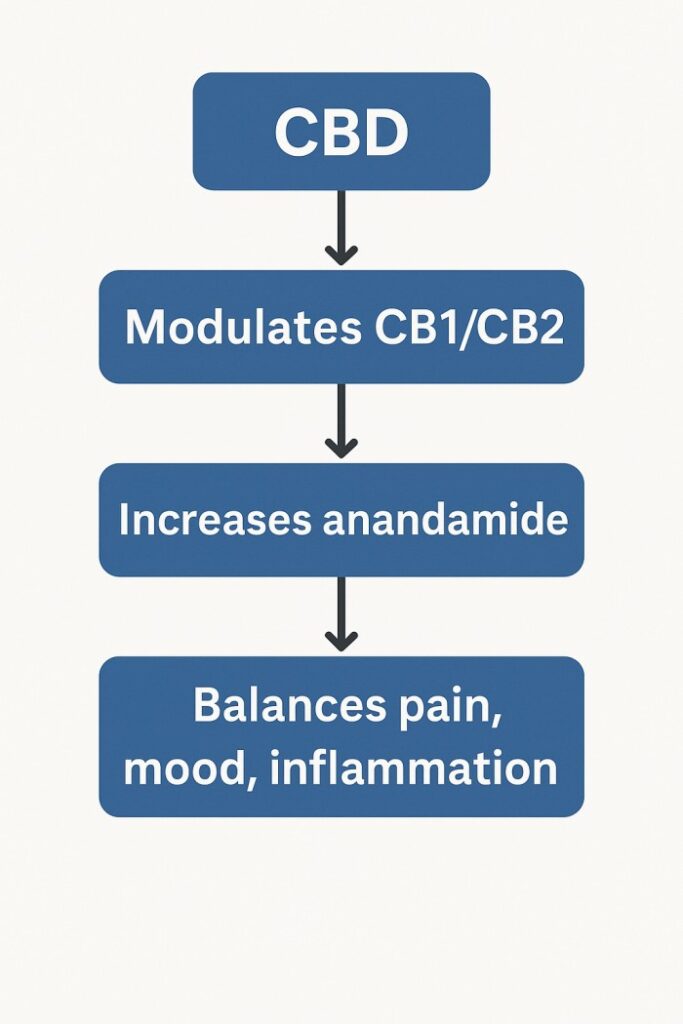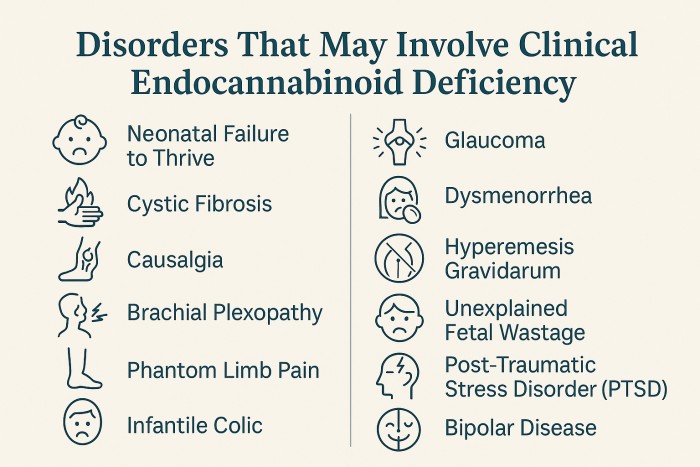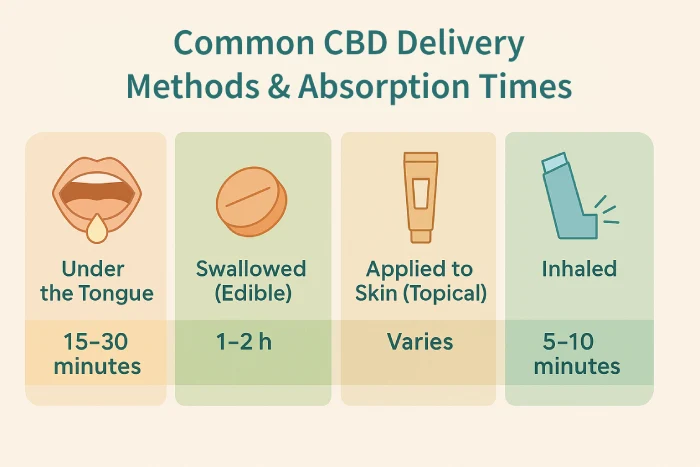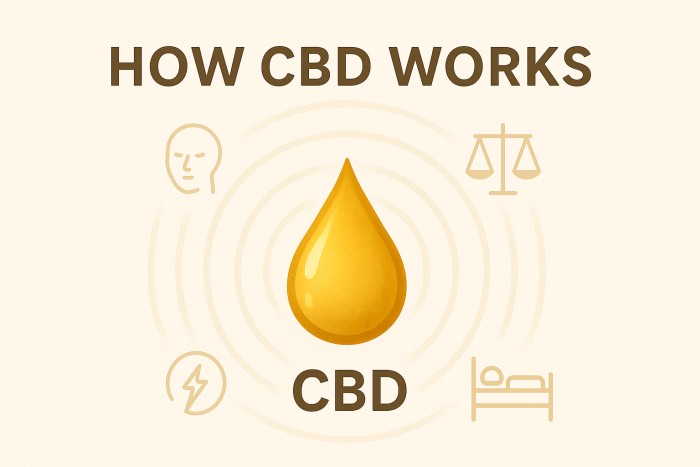Overview: Understanding How CBD Works in the Body
- Key Mechanism: CBD primarily interacts with the endocannabinoid system (ECS), a network regulating pain, mood, sleep, and more.
- Non-Psychoactive: Unlike THC, CBD does not cause a “high,” making it appealing for therapeutic use.
- Multiple Pathways: CBD also affects serotonin, pain, and inflammation receptors, contributing to its diverse effects.
- Research Status: Evidence supports CBD’s role in epilepsy and pain relief, but more studies are needed for other benefits.
- Controversy: Claims about CBD’s benefits often outpace scientific evidence, and product quality varies widely.
What is CBD and Why Does It Matter?
Cannabidiol (CBD) is a compound found in hemp and cannabis plants, known for its potential health benefits without the psychoactive effects of THC.
It’s used in products like oils, gummies, and creams, often for pain, anxiety, or sleep issues.
Understanding how CBD works can help you decide if it’s right for you.
How Does CBD Interact with the Body?
CBD mainly works through the endocannabinoid system (ECS), which helps balance bodily functions like pain, mood, and sleep.
It doesn’t directly bind to ECS receptors but influences them, increasing natural compounds that regulate these processes.
CBD also interacts with other receptors, like those for serotonin and pain, which may explain its calming and pain-relieving effects.
What Are the Potential Benefits?
Research suggests CBD may help with epilepsy (e.g., FDA-approved Epidiolex), chronic pain, anxiety, and inflammation.
However, evidence is stronger for some uses than others, and more studies are needed to confirm broader benefits.
Is It Safe?
CBD is generally safe, but can cause side effects like drowsiness or diarrhea.
It may interact with medications, so consult a doctor before use.
Product quality is a concern, so choose lab-tested brands.
Introduction
Cannabidiol (CBD) has surged in popularity, appearing in everything from wellness products to prescription medications.
As a non-psychoactive compound derived from hemp, CBD offers potential therapeutic benefits without the “high” associated with tetrahydrocannabinol (THC).
Despite its widespread use, many people remain unclear about how CBD interacts with the body.
This comprehensive guide explores CBD’s mechanisms, focusing on its interaction with the endocannabinoid system (ECS) and other biological pathways, supported by the latest research from authoritative sources like Harvard Health, Mayo Clinic, and WebMD.
What is CBD?
CBD is one of over 100 cannabinoids found in the Cannabis sativa plant, primarily sourced from hemp, which contains less than 0.3% THC.
Unlike THC, which binds to brain receptors to produce psychoactive effects, CBD is non-psychoactive, making it appealing for those seeking relief from conditions like pain, anxiety, or epilepsy without mind-altering effects.
CBD is available in various forms, including oils, edibles, topicals, and the FDA-approved drug Epidiolex for epilepsy (FDA Approval).

The Endocannabinoid System (ECS): The Body’s Master Regulator
The endocannabinoid system (ECS) is a complex cell-signaling network discovered in the 1990s during research on THC.
It plays a critical role in maintaining homeostasis, or balance, across various physiological processes, including:
- Pain sensation
- Mood and emotions
- Sleep
- Appetite and digestion
- Immune system responses
- Inflammation
- Memory and learning
- Reproduction and fertility
Components of the ECS
The ECS comprises three main components:
| Component | Description |
|---|---|
| Endocannabinoids | Naturally occurring molecules similar to plant cannabinoids. Key examples include anandamide (AEA) (linked to appetite, memory, euphoria) and 2-arachidonoylglycerol (2-AG) (tied to emotional regulation, neuroprotection). |
| Receptors | CB1 receptors (in the brain and central nervous system) regulate movement, pain, mood, and memory. CB2 receptors (in peripheral tissues and immune cells) influence pain and inflammation. |
| Enzymes | Break down endocannabinoids after use. Fatty acid amide hydrolase (FAAH) degrades AEA, and monoacylglycerol lipase (MAGL) degrades 2-AG. |
The ECS acts as a regulatory bridge, ensuring bodily systems work harmoniously.
When stress, injury, or illness disrupts balance, the ECS helps restore equilibrium by maintaining the body’s internal balance.
Dr. Tanja Bagar explains that the ECS acts as a general protective mechanism, activating when cellular homeostasis is disrupted to restore equilibrium.
For instance, a study published in the journal Neurochemistry discusses how the ECS is involved in the homeostatic response to acute stress, highlighting its role in modulating stress responses and maintaining internal stability.
Additionally, the study in Frontiers In Behavioral Neuroscience provides an overview of the ECS, emphasizing its involvement in regulating various physiological processes, including appetite, cancer, cardiovascular diseases, fertility, immune functions, memory, neuroprotection, and pain modulation, all of which are critical during periods of stress or illness.
These insights underscore the ECS’s function as a key player in the body’s ability to adapt to and recover from various challenges, ensuring overall well-being.

How CBD Interacts with the ECS
Unlike THC, which binds directly to CB1 and CB2 receptors, CBD has a more indirect and nuanced interaction with the ECS.
Its mechanisms include:
- Modulating Receptor Activity:
- Research indicates that cannabidiol (CBD) does not strongly bind to CB1 or CB2 receptors but instead modulates their activity. Specifically, CBD acts as a negative allosteric modulator of the CB1 receptor, meaning it binds to a different site on the receptor and changes its shape, thereby reducing the receptor’s ability to bind with agonists like THC. This modulation can attenuate the psychoactive effects of THC.
- This modulation enhances ECS signaling, affecting pain, mood, and inflammation.
- Supporting ECS Balance:
- Research suggests CBD may address endocannabinoid deficiencies linked to conditions like chronic pain, anxiety, depression, fibromyalgia, and migraines (Study on ECS Deficiency). By boosting ECS activity, CBD may help restore balance in these conditions.
Other Mechanisms of CBD
CBD’s effects extend beyond the ECS, interacting with various receptors and pathways:
- Antioxidant Properties: A study in the journal Antioxidants explains the mechanisms by which CBD exerts its antioxidant effects. The research outlines how CBD influences redox homeostasis and supports cellular protection, further underscoring its potential in managing conditions characterized by oxidative stress.
- Anti-inflammatory Effects: A 2020 research indicates that cannabidiol (CBD) possesses significant anti-inflammatory properties, primarily through its ability to reduce inflammatory cytokines and modulate immune cell activity. These effects suggest potential therapeutic applications for conditions characterized by chronic inflammation, such as arthritis, inflammatory bowel disease, and autoimmune disorders.
- Neuroprotective Effects: CBD protects neurons from damage, showing promise for epilepsy, multiple sclerosis, and Parkinson’s (Study).

Variability in Effectiveness
CBD’s effects vary by individual due to factors like metabolism, dosage, and consumption method.
Some users experience relief after a single dose, while others require consistent use.
Common delivery methods include:
| Method | Description | Absorption Speed |
|---|---|---|
| Sublingual | Oils or tinctures under the tongue. | Fast (15-30 min) |
| Oral | Edibles or capsules swallowed. | Slow (1-2 hours) |
| Topical | Creams or lotions applied to skin. | Localized, variable |
| Inhalation | Vaping or smoking for rapid effects. | Very fast (5-10 min) |
Conclusion
CBD works primarily through the endocannabinoid system, modulating CB1 and CB2 receptors and increasing endocannabinoid levels to regulate pain, mood, and inflammation.
Beyond the ECS, CBD interacts with TRPV1, 5-HT1A, and PPARγ receptors, offering antioxidant, anti-inflammatory, and neuroprotective effects.
Research supports its use for epilepsy, pain, and anxiety, but broader claims require further study.
While generally safe, CBD’s unregulated market and potential drug interactions necessitate caution.
By choosing high-quality, lab-tested products and consulting a doctor, consumers can safely explore CBD’s potential benefits.
About The Author
Joseph Powers is the founder of Legal CBD Idaho and a trusted voice in Idaho’s hemp and CBD space. With over a decade of experience in cannabis compliance and education, Joseph is committed to helping Idahoans confidently understand what’s legal, what works, and where to buy safe, effective CBD products in the state.
A Twin Falls local, Joseph brings a consumer-first approach to navigating Idaho’s strict laws around hemp-derived CBD. He personally reviews legal updates, verifies product claims, and explains everything in plain English—so you can make informed, stress-free decisions about your wellness.
Joseph is not affiliated with any CBD brand, ensuring every review and guide on this site is unbiased and rooted in facts, not hype. Whether you're just curious or looking for trusted products that meet Idaho’s 0.0% THC requirement, his goal is simple: to give you honest answers backed by research, not rumors.
Got a question about CBD in Idaho? Email Joseph directly at joe@legalcbdoilidaho.com.

